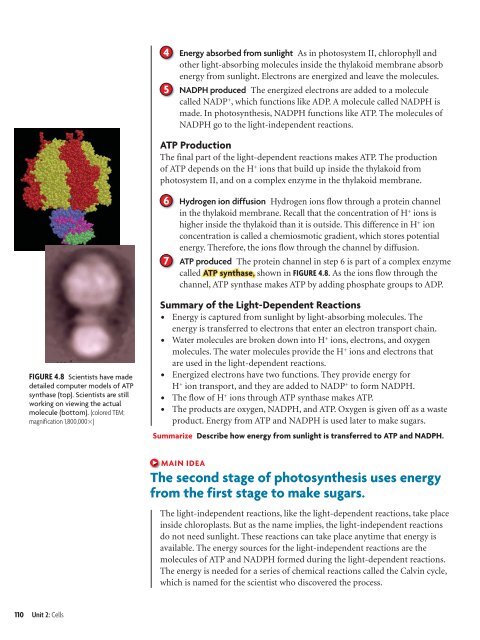Cells and Energy
Cells and Energy
Cells and Energy
You also want an ePaper? Increase the reach of your titles
YUMPU automatically turns print PDFs into web optimized ePapers that Google loves.
4 <strong>Energy</strong> absorbed from sunlight As in photosystem II, chlorophyll <strong>and</strong>other light-absorbing molecules inside the thylakoid membrane absorbenergy from sunlight. Electrons are energized <strong>and</strong> leave the molecules.5 NADPH produced The energized electrons are added to a moleculecalled NADP + , which functions like ADP. A molecule called NADPH ismade. In photosynthesis, NADPH functions like ATP. The molecules ofNADPH go to the light-independent reactions.ATP ProductionThe final part of the light-dependent reactions makes ATP. The productionof ATP depends on the H + ions that build up inside the thylakoid fromphotosystem II, <strong>and</strong> on a complex enzyme in the thylakoid membrane.6 Hydrogen ion diffusion Hydrogen ions flow through a protein channelin the thylakoid membrane. Recall that the concentration of H + ions ishigher inside the thylakoid than it is outside. This difference in H + ionconcentration is called a chemiosmotic gradient, which stores potentialenergy. Therefore, the ions flow through the channel by diffusion.7 ATP produced The protein channel in step 6 is part of a complex enzymecalled ATP synthase, shown in FIGURE 4.8. As the ions flow through thechannel, ATP synthase makes ATP by adding phosphate groups to ADP.FIGURE 4.8 Scientists have madedetailed computer models of ATPsynthase (top). Scientists are stillworking on viewing the actualmolecule (bottom). (colored TEM;magnification 1,800,000)Summary of the Light-Dependent Reactions• <strong>Energy</strong> is captured from sunlight by light-absorbing molecules. Theenergy is transferred to electrons that enter an electron transport chain.• Water molecules are broken down into H + ions, electrons, <strong>and</strong> oxygenmolecules. The water molecules provide the H + ions <strong>and</strong> electrons thatare used in the light-dependent reactions.• Energized electrons have two functions. They provide energy forH + ion transport, <strong>and</strong> they are added to NADP + to form NADPH.• The flow of H + ions through ATP synthase makes ATP.• The products are oxygen, NADPH, <strong>and</strong> ATP. Oxygen is given off as a wasteproduct. <strong>Energy</strong> from ATP <strong>and</strong> NADPH is used later to make sugars.Summarize Describe how energy from sunlight is transferred to ATP <strong>and</strong> NADPH.MAIN IDEAThe second stage of photosynthesis uses energyfrom the first stage to make sugars.The light-independent reactions, like the light-dependent reactions, take placeinside chloroplasts. But as the name implies, the light-independent reactionsdo not need sunlight. These reactions can take place anytime that energy isavailable. The energy sources for the light-independent reactions are themolecules of ATP <strong>and</strong> NADPH formed during the light-dependent reactions.The energy is needed for a series of chemical reactions called the Calvin cycle,which is named for the scientist who discovered the process.110 Unit 2: <strong>Cells</strong>
















